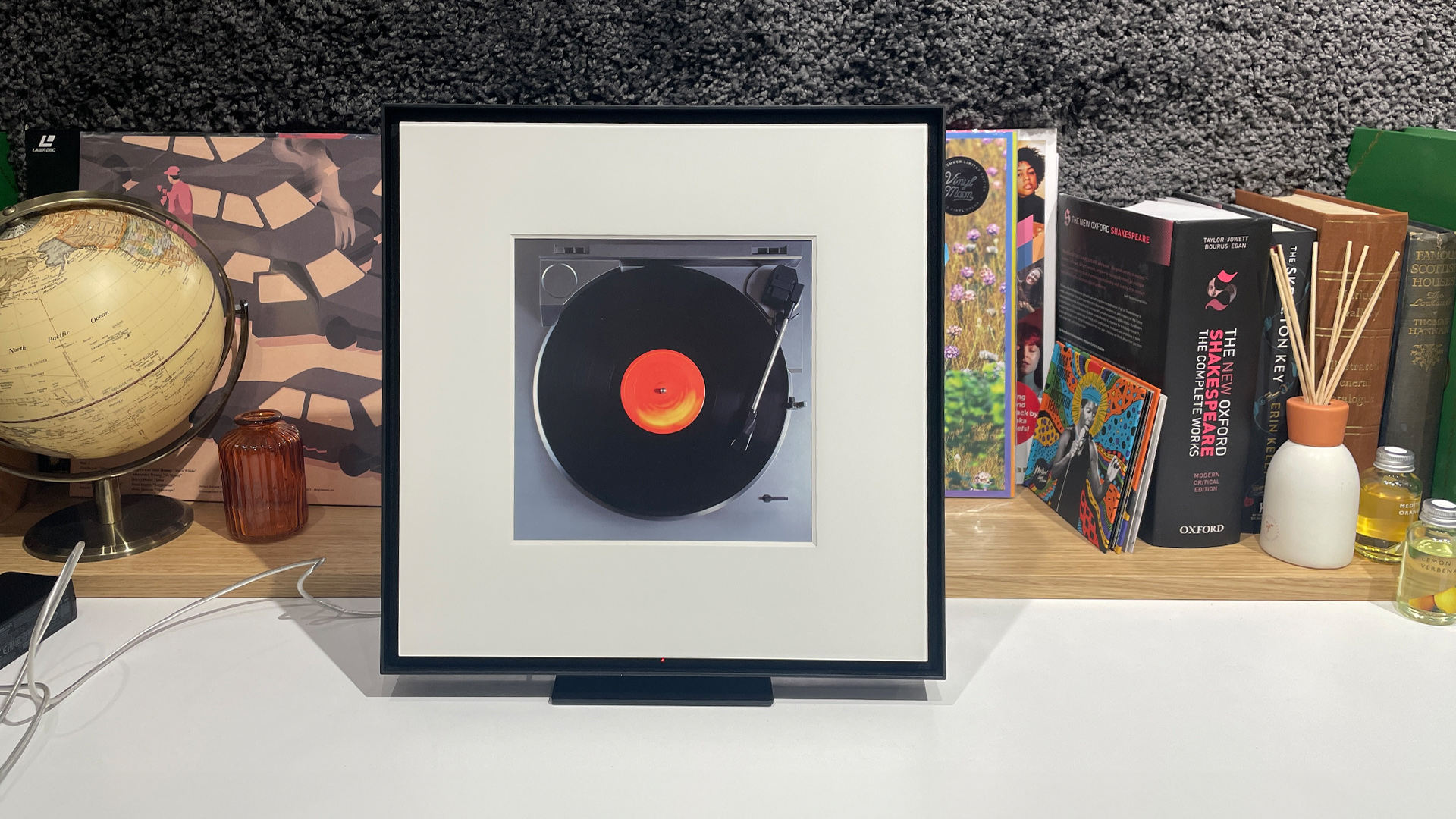What Hi-Fi? Verdict
The Samsung Music Frame is an intriguing idea with visual appeal, but the disappointing sound quality means it needs a second draft.
Pros
- +
Attractive, sturdy design
- +
Can be used as a photo frame
- +
Great wireless streaming features
- +
Wide, evenly balanced spread of sound
- +
Solid sound, weighty bass, goes loud
Cons
- -
Expensive
- -
Customisable options all cost extra – it starts to add up
- -
Inoffensive but not very detailed sound
- -
Sound lacks nuance, dynamic contrast and rhythmic prowess
- -
Better and cheaper rivals easily beat it for detail, authenticity and energy
Why you can trust What Hi-Fi?
Products that blend audio and lifestyle successfully are hard to come by. The options include streamlining black boxes to make them sleeker; creating rather bland, anonymous products that are designed to be heard but not seen; or going for a decidedly retro aesthetic. Samsung has gone for a different approach: a wireless speaker that looks like a picture frame.
The Samsung Music Frame can be hung on the wall or set on a table just like a normal (if large) photo frame, and you can play music wirelessly through it too. It’s an ingenious way to incorporate an audio device into the home, but to borrow parlance from a popular baking competition show, it is a true showstopper or is the concept half-baked?
Price
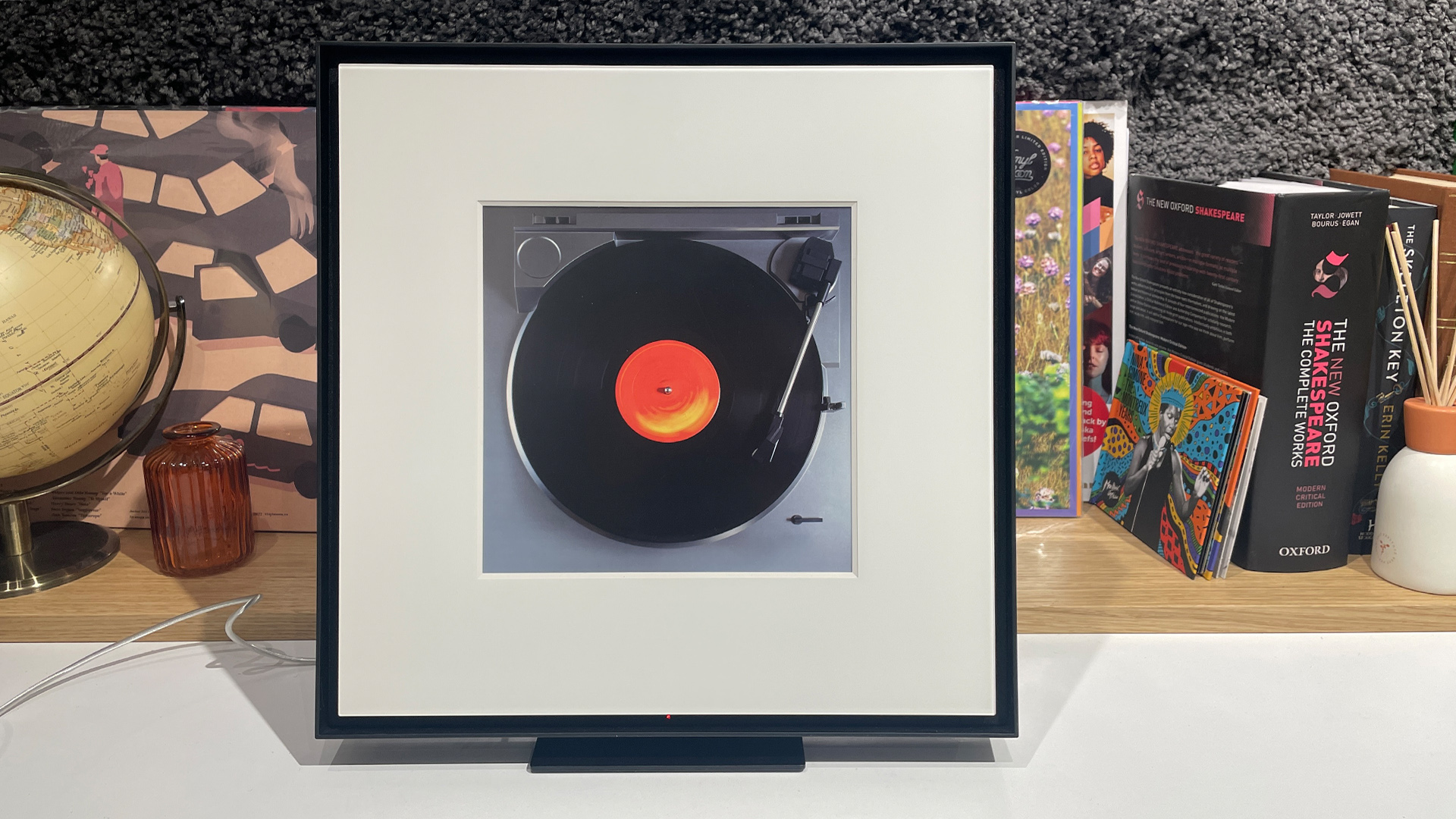
The Samsung Music Frame made its debut not just with an intriguing concept but with an eyebrow-raising price. It launched at a substantial £499 / $600 / AU$699. That’s a far more premium price than we would’ve anticipated for this photo frame/speaker concept; it does mean our expectations of quality and execution are quite high. Wireless speaker rivals at this level include the Sonos Era 300 (£449 / $449 / AU$749) and Audio Pro C20 (£450 / $550 / AU$999) – both five-star What Hi-Fi? Award-winners.
The price has come down since launch and you can now pick the Music Frame up for around £399 / $250 / AU$580. Samsung isn’t the first brand to have this idea, though. IKEA got there first with its Symfonisk Picture Frame WiFi Speaker collaboration with Sonos, and this costs a more affordable £220 (originally £179) / $200 / AU$299. You’ll also have to keep in mind that changing the art panel and photos on the Music Frame – more on this later – will cost extra on top of the speaker itself.
Build & design
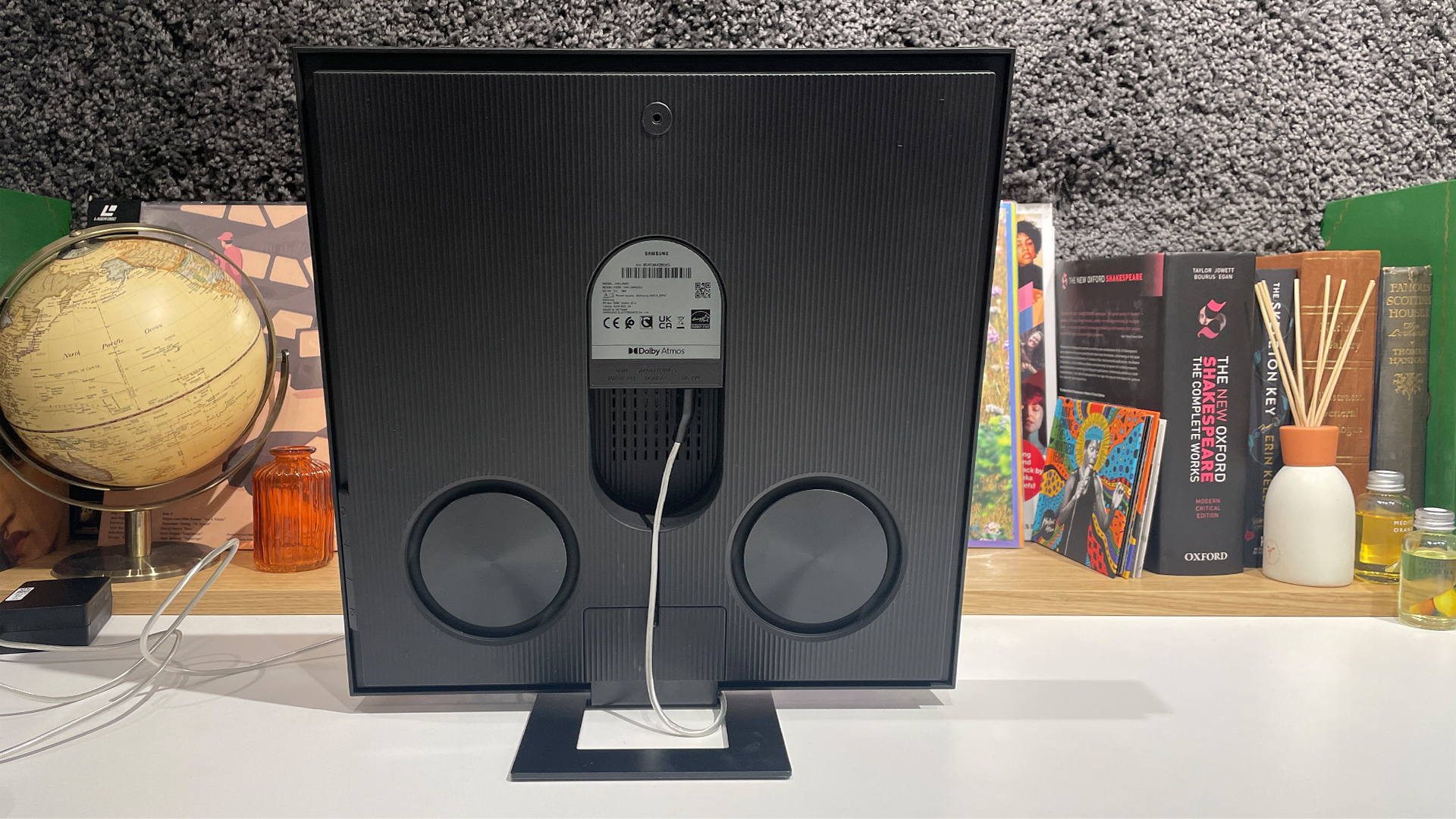
Overall the construction feels sturdy and robust. You can either wall-mount the Frame or put it on a stand that slots in neatly at the back and gives it a tilt; no matter where you place it, no one will be any the wiser that there’s a wireless speaker included. It’s an attractive design that we think will blend into most living spaces. Samsung’s promotional photos display it in carefully decorated interiors, but even on our testing room’s functional desk amidst vinyl records, books and random accessories, the Music Frame doesn’t look out of place. Don’t like the standard black bezel frame surrounding the speaker? You can change it to a white bezel with snap-on panels – that will cost you an additional £69 / $60.
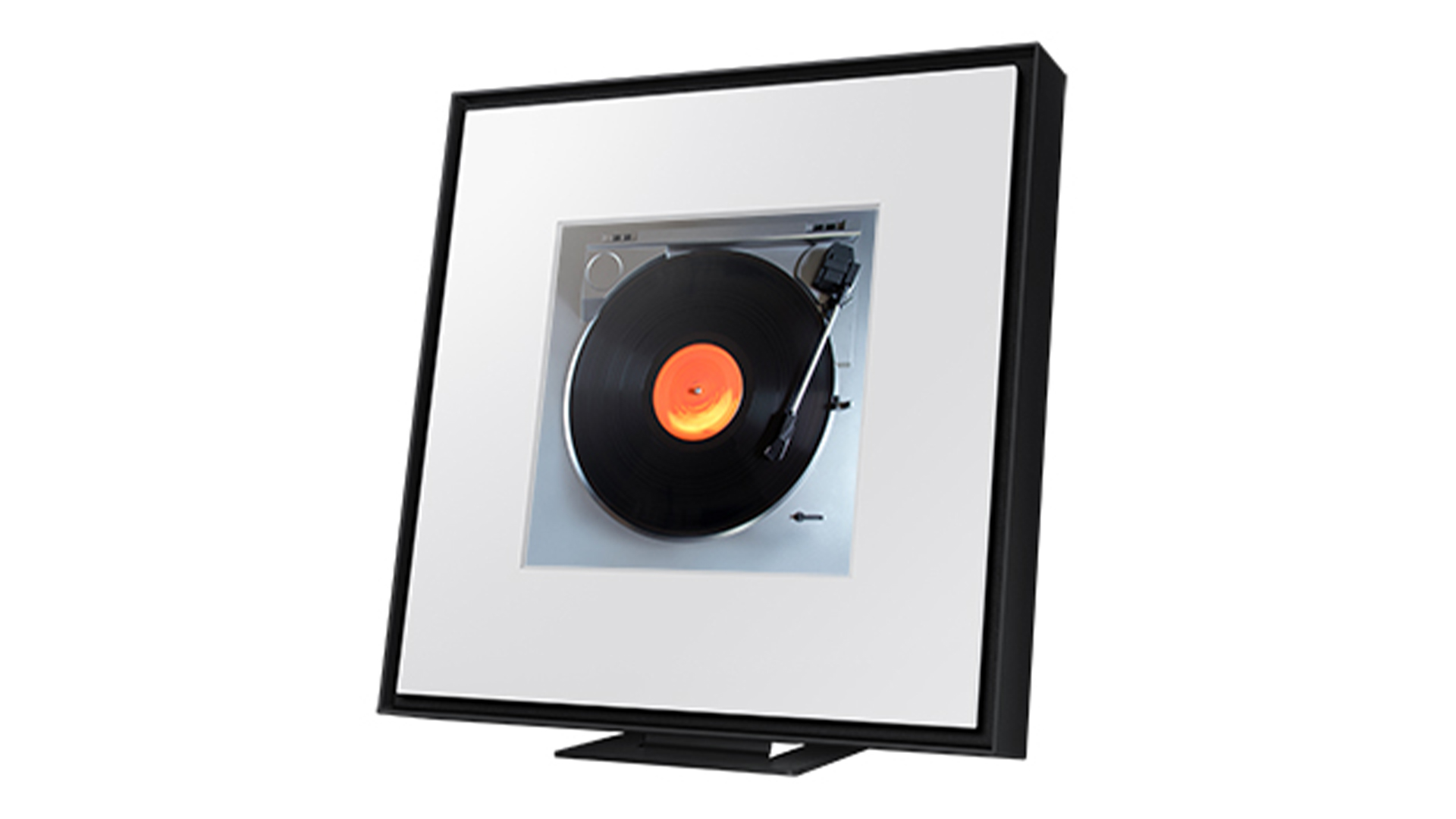
Bluetooth 5.2
Streaming features AirPlay 2, Chromecast built-in, wi-fi, Spotify Connect, Tidal Connect, Dolby Atmos, Roon Tested, Alexa
Connections Optical input
Battery life N/A (mains-powered)
App? Yes
Dimensions (hwd) 36.5 x 35 x 14.3cm
Weight 5.9kg
The frame/speaker is rather heavy at 5.9kg, which is worth bearing in mind if you aim to hang it on the wall. The wall mount kit and instructions are helpfully included in the box, and the stand is also easy to install. It’s worth bearing in mind that the Music Frame needs to be plugged into the mains to work, so there is a cable trailing from under the unit.
We wish there was a quick start guide included in the box or a QR code guiding us to the app or information online, as even for seasoned tech reviewers, we were puzzled at start about how to a) turn it on, b) get it into Bluetooth pairing mode, and c) customise the frame with different photos. We turned to Google and found a host of information and video guides to using the Music Frame and detaching the art panel, but it’s disappointing that there’s nothing in the box to help those not quite as tech-savvy to get started. You’ll need to download the Smart Things app to add the Music Frame to your home network and get it working, control music and access sound settings, but there are also some controls on the Frame itself. They’re hidden away behind the bottom-right corner of the frame: four touch-capacitive buttons for selecting sources (wi-fi, Bluetooth, optical), volume up and down, and turning the internal microphone on or off. These buttons are quite flush to the frame and they’re also quite (overly) sensitive. Every time we adjusted the position of the Frame on our desk, we kept brushing against the mic on/off button and triggered it easily – it can get annoying pretty quickly hearing the voice prompt letting you know you’ve accidentally done it again.
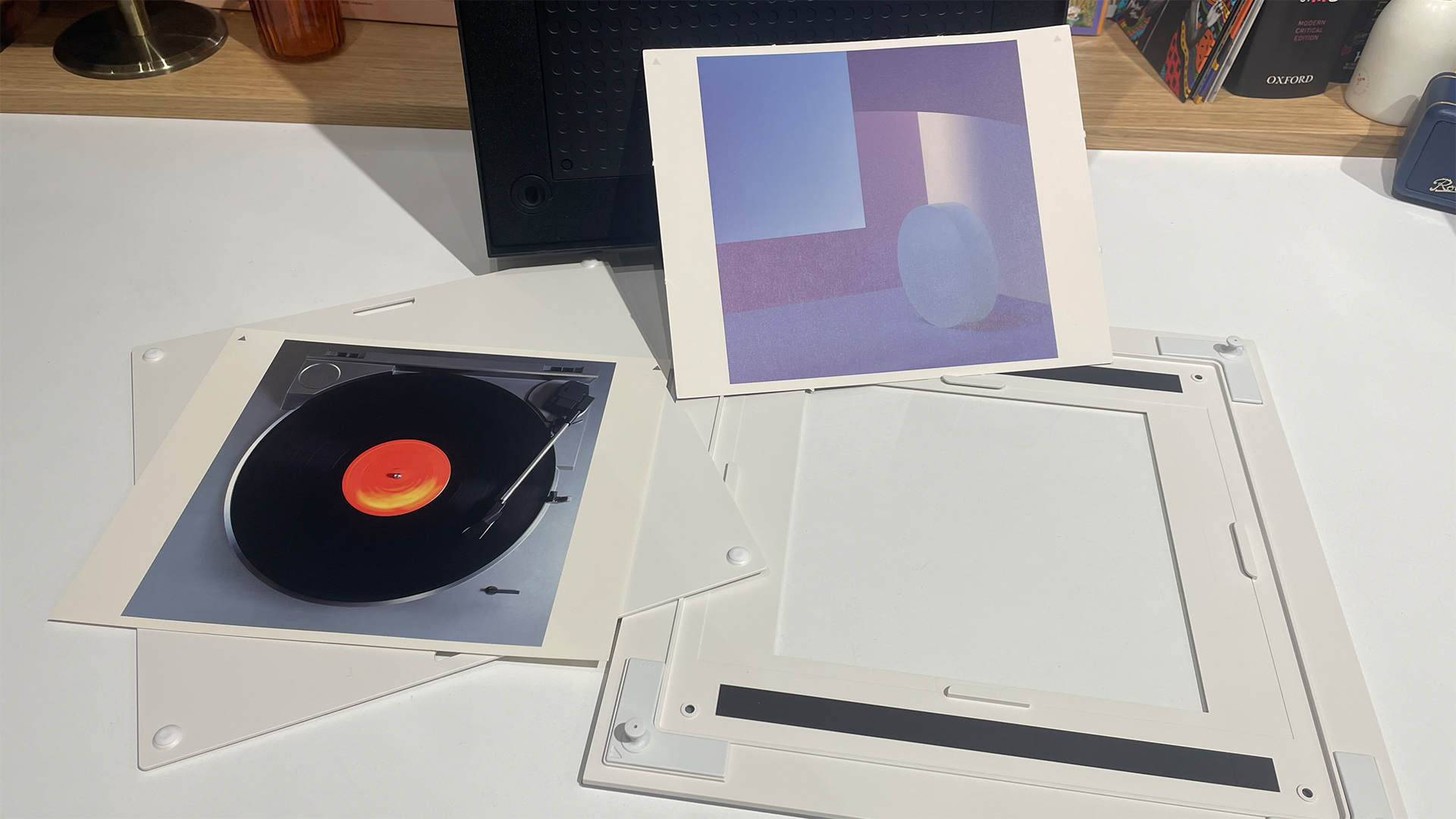
Of course, if your Frame is wall-mounted, this will be less of an issue. There is a small discrepancy in that there is no scope to select inputs or turn mic on/off in the Smart Things app itself. The Music Frame does responsively change sources when playing music from your smartphone using different streaming methods, but we think the mic adjustment could’ve been more accessible. Let’s hope you don’t position the Frame too high on the wall that you can’t reach the buttons.
The photo frame aspect of this speaker itself is customisable in two ways: a standard photo print and the swappable art panel. The full art panel covering the Frame is made of acrylic and measures 13 x 13 inches (or 33 x 33cm); it can be lifted off the unit and detached easily (and popped back in securely) and there is a slot at the back of this panel to insert a printed photo (the video guides are helpful here). Samsung recommends an 8 x 10-inch photo print out, but note that this will get cropped to a square ratio as the visible window surrounded by the white mat measures 7.5 x 7.5 inches (approx. 19 x 19cm). The Frame comes with a generic photo installed as standard and there’s an extra image included in the box to try out. You may not be in the habit of printing out physical photos in this age of smartphone-stored digital photos, but the Music Frame’s ideal customer will likely make the effort. Either way, swapping out the photo print in the frame is easy to do, and gives the speaker a personal feel that conventional audio products normally don’t have.
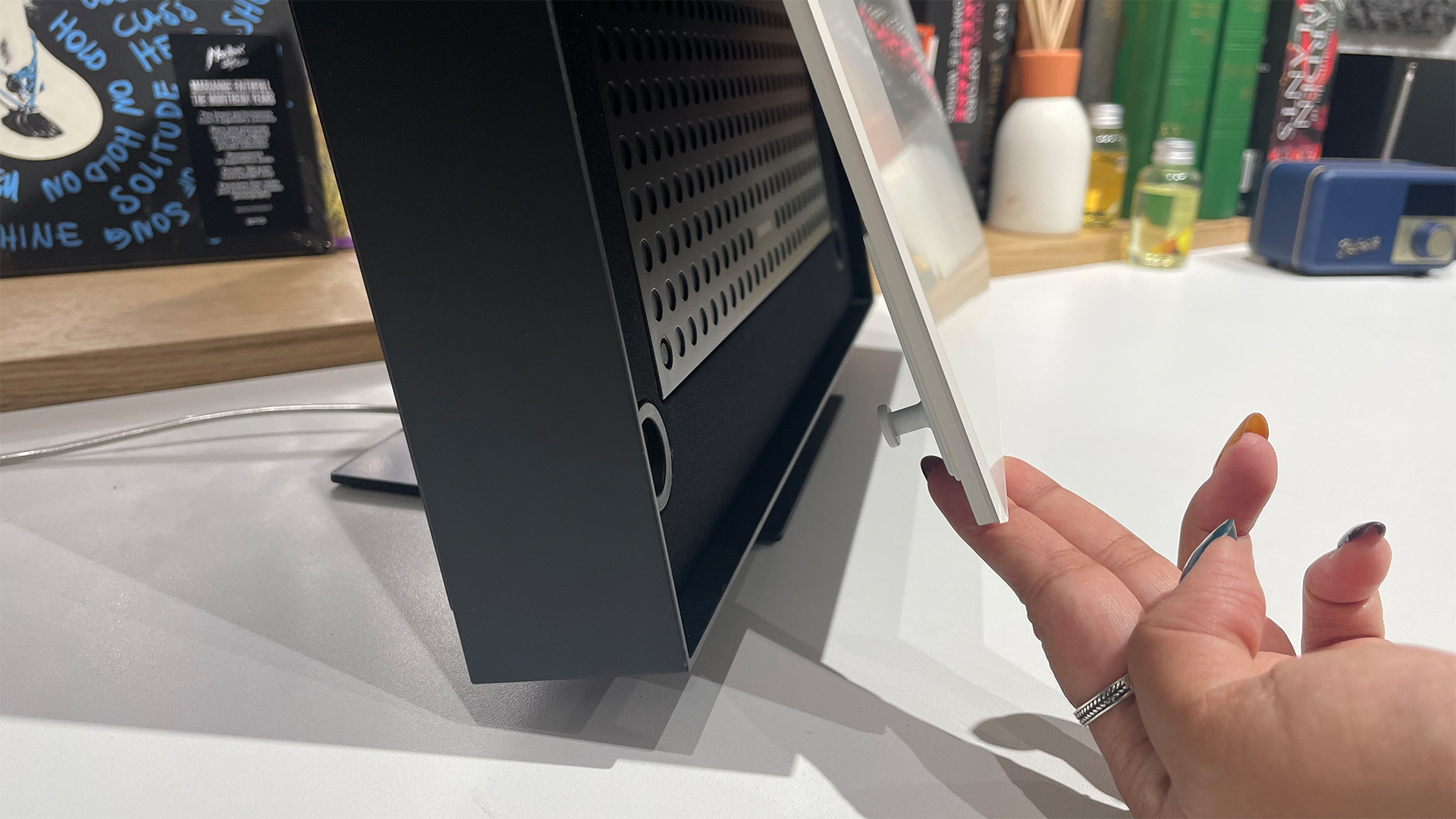
To replace the full art panel, however, you’ll need to order this online at an additional cost. You can go through Samsung’s official MusicFrameLab online portal to buy pre-set artwork or upload your own image, and this will cost you a substantial £50 / $50 per panel. If you like changing your interior style a lot or want various options to display, this can start to add up. There are also third-party sites such as Marpple (South Korea) or Shutterfly (USA) that let you create your own art panels with various aspect ratio and customisable options (costing around $46-$60 per panel, before shipping).
As a photo frame, Samsung has made the Music Frame very customisable, but all of these elements cost extra – and on top of the asking price, it all starts to get rather expensive. We can’t help but wonder why Samsung didn’t opt for a digital picture screen, which would have been more immediately customisable out of the box (and at less cost, too). After all, you can select different digital wallpapers to display on the Samsung Frame TV using the Smart Things app, so it’s not a stretch to assume the same concept could’ve been carried over to the Music Frame. The physical photo element is tactile and does look nice, but we can’t help but think that a digital frame might have felt more innovative and user-friendly.
Features
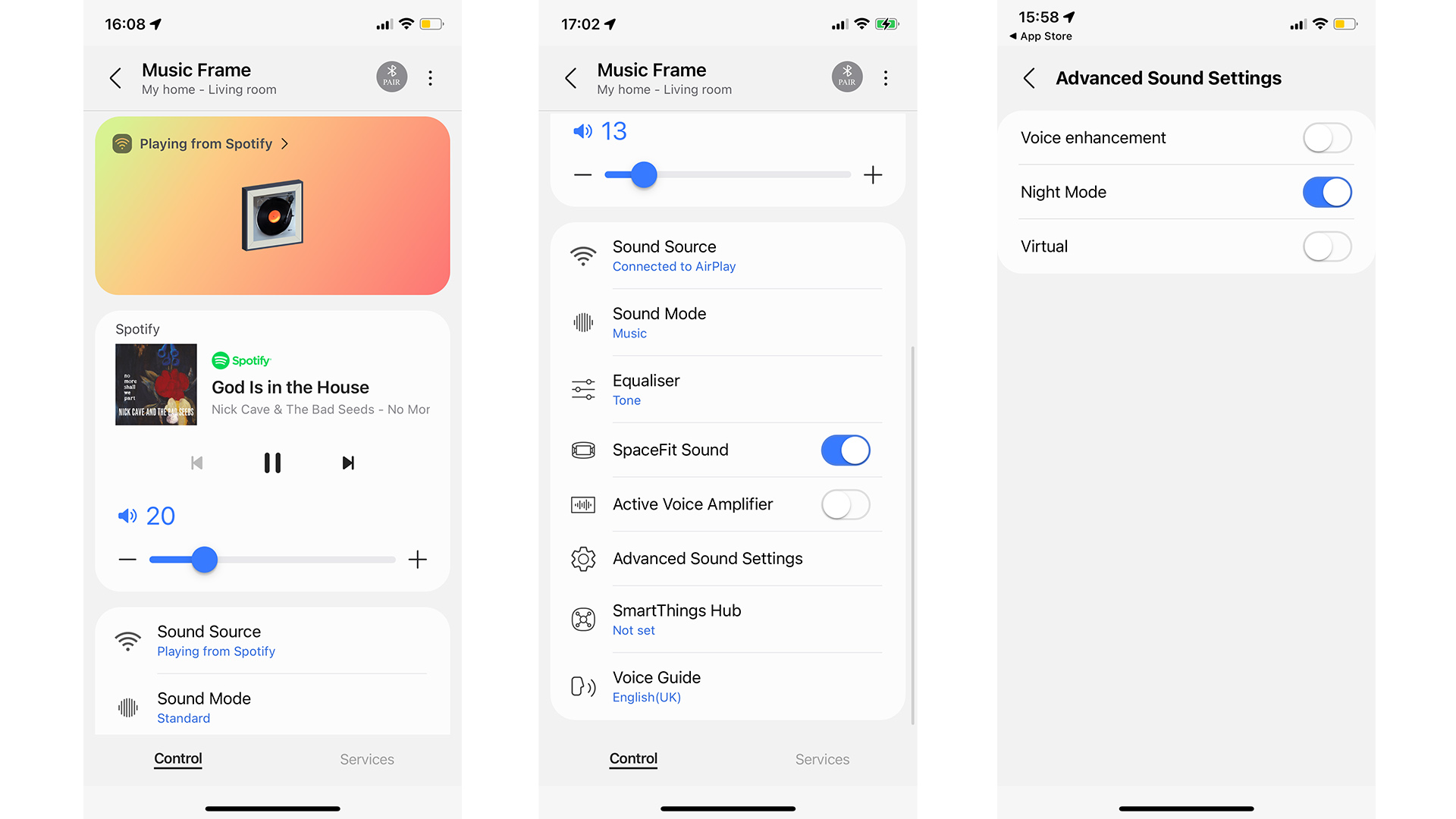
On the wireless streaming front, the Samsung Music Frame (official name HW-LS60D) is well-featured and it operates just as you’d expect a premium wireless speaker to. Once connected to your home wi-fi, you get access to Spotify Connect and Tidal Connect, while AirPlay 2 and Chromecast built-in let you stream any music or podcast from your smartphone to the speaker. It’s even Roon Tested and you can use Alexa voice control, too.
Once you pair your device with Bluetooth (How? Select it as an input using the source button on the Frame, then hold down the mic button for five seconds to get it in pairing mode…), it’s all plain sailing. The Smart Things app is a little slow to display what’s being played, but it does so accurately and, unless you regularly need to access the sound settings, you’ll be using the native music apps directly for playing music and changing volume anyway.
The Music Frame also supports Dolby Atmos playback, although the output remains two-channel. If you have a full Samsung AV system, it can even be used as a TV speaker (either on its own or in a pair) with a compatible Samsung TV (such as 2024’s QN95D sets) and soundbar thanks to Samsung’s Q Symphony audio technology, which uses all connected devices to play sound together. There is also a digital optical input and a port for plugging in a SmartThings Dongle.
There are a few sound settings in the Smart Things app worth mentioning. We like the Music mode the best, over Standard and Adaptive (which uses AI to analyse the content). The SpaceFit Sound option uses the Frame’s built-in mic to analyse the room it’s in and optimise the sound – while this made the bass a little too boomy for our liking in our test room, it’s worth trying out in your space to hear the difference. There is a fully adjustable seven-band equaliser and treble and bass controls, while further settings include Voice (which boosts the mids and sounds horribly mechanical and harsh – avoid), Night (which flattens dynamics and subdues volume when you’re listening at unneighbourly hours), and Virtual (greater 3D sound).
Sound
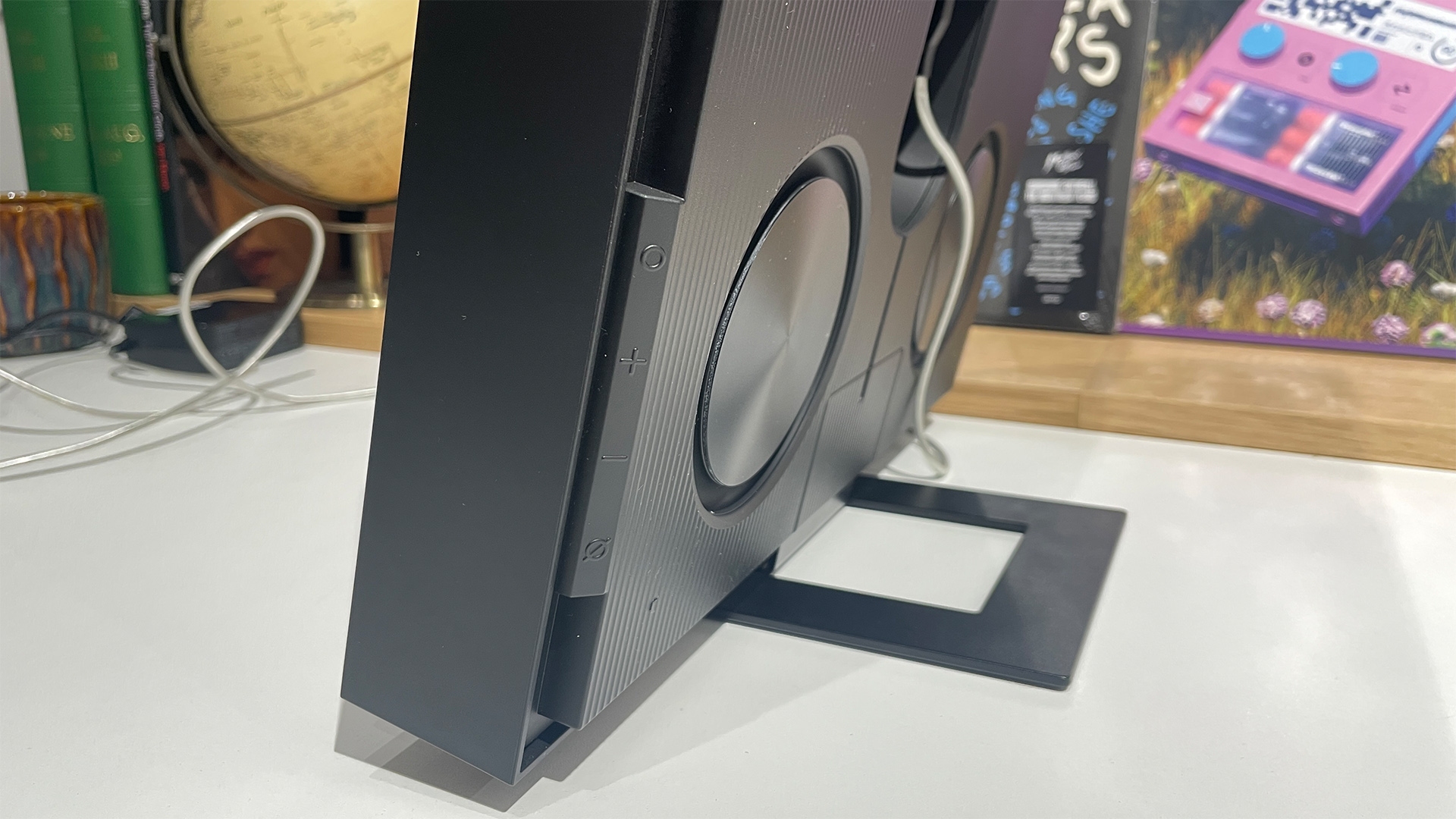
How does the Music Frame actually make a sound? The speaker features six drivers with patented waveguide technology to spread the sound out wide, and with built-in amplification (no power rating is given) all housed within the thick frame. With a solid acrylic panel fitted so close to the front panel (under which lies the two tweeters and two midrange drivers), sound is fired out through the small 9mm gap between the frame’s edge and the detachable art panel. Samsung says this distance was carefully calculated so that the high and mid frequencies could be projected clearly through this gap. Meanwhile, the vibrations from the rear two woofers (which are visible) are designed not to create undue noise when the Frame is hung on the wall.
We weren’t able to wall-mount the Frame in our test room, but even when placed right up against the wall, we could hear how the powerful bass can easily vibrate certain surfaces around it. What strikes us immediately is the sheer amount of volume coming out of this speaker unit – we barely had to crank up the volume to listen at normal levels, but it can go very loud and easily fill a large space.
The spread of sound is impressively wide and large-scaled. The Frame disperses sound in an evenly balanced manner, and even as we walked around the room, its balance and character didn’t change. Tonally, the Frame is fairly even – it’s a very solid sound. Bass notes are meaty and have heft, while there’s no spikiness or thinness to the treble.
Play a Dolby Atmos track – Billie Eilish’s Chihiro and Snoop Dog’s Gin & Juice via Tidal – and the sound seems to emit beyond the Frame’s physical confines. The Music Frame’s full-bodied tone and wide dispersion is easy to listen to.
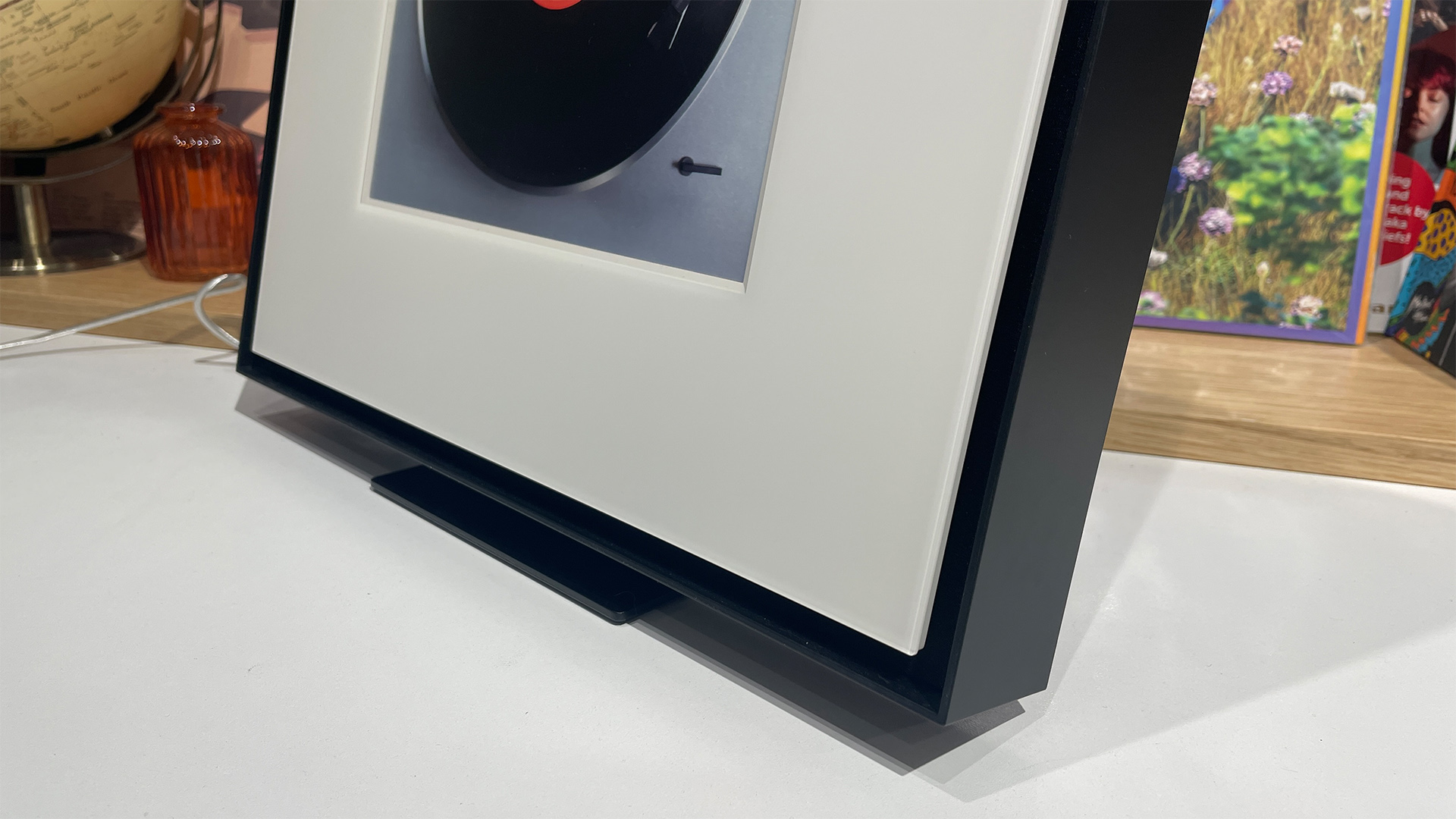
However, there is a distinct lack of detail overall. The solid, expansive sound is nice, but the Frame seems unwilling to dig into further details and reveal subtleties; it also isn’t quite able to deliver the dynamic contrasts that make music so engaging and involving. Run The Jewels’ sizzling attitude and lively energy doesn’t fully come across on Legend Has It, while we don’t hear much of the delicate nuances or crisply whispered textures of Eilish’s vocals. The Jurassic Park theme’s dynamics fall rather flat and there is little sense of a living, breathing orchestra working as one and building up to an exciting crescendo. The textures of instruments are quite hazy and don’t sound quite real or accurate; we’d like to have heard more clarity and more rhythmic agility.
We stream SBTRKT’s Wildfire and Erik Satie’s Gnossienne No. 1, and while the basslines and piano notes have weighty substance, we’d like them to have more shape and stop and start with greater precision. This relaxed presentation might be fine for background listening, but we want the Music Frame to deliver music with greater punch and agility for a more exciting and faithful performance.
It doesn’t help that there is a solid panel in front of the speaker. Take the art panel off and voices are clearer and the bass has less of a booming quality; put back on, the sound is immediately muffled. The Music Frame can’t quite compete with its Sonos and Audio Pro rivals at this level, and even a cheaper Bluetooth-only speaker like the JBL Xtreme 4 delivers music with better clarity, rhythmic precision and dynamic expression, even if it’s more small-scaled than the Samsung.
At this price, we were hoping for more. Even if you value the customisable photo frame aspect of this product first and foremost, we would still imagine you would want a better, more involving sound performance from a premium wireless speaker.
Verdict
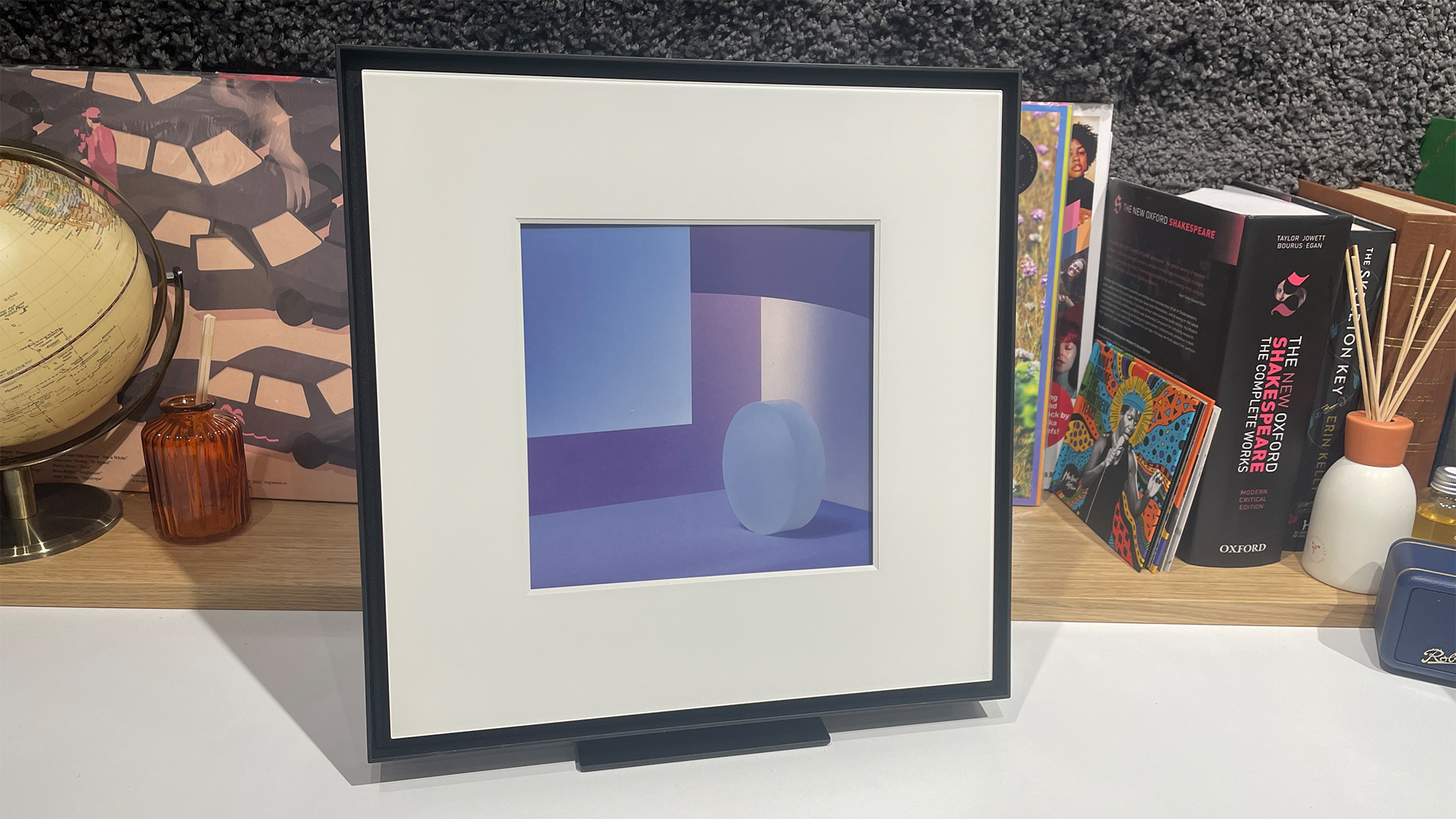
The Samsung Music Frame is a fun idea that has instant visual appeal. At this price, however, we were hoping for more attention to detail and a higher level of sound quality. We can see its appeal if you have the wherewithal to customise the photos and art panel, but for the asking price, the disappointing sound and usability quirks stop us from recommending it fully.
SCORES
- Sound 3
- Build 4
- Features 5
MORE:
Read our review of the Sonos Era 300
Also consider the Audio Pro C20
Best wireless speakers: tried and tested by our expert team
What Hi-Fi?, founded in 1976, is the world's leading independent guide to buying and owning hi-fi and home entertainment products. Our comprehensive tests help you buy the very best for your money, with our advice sections giving you step-by-step information on how to get even more from your music and movies. Everything is tested by our dedicated team of in-house reviewers in our custom-built test rooms in London, Reading and Bath. Our coveted five-star rating and Awards are recognised all over the world as the ultimate seal of approval, so you can buy with absolute confidence.
